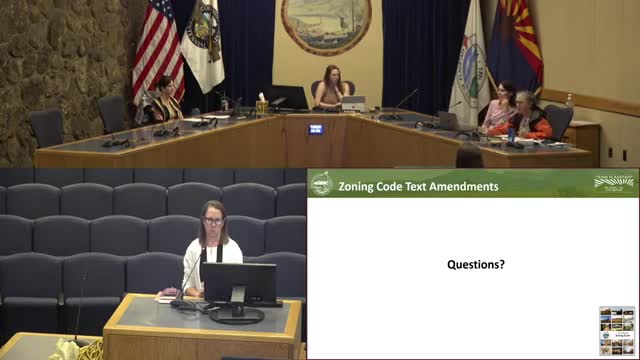Zoning changes spark debate over affordable housing and history
August 22, 2024 | Flagstaff City, Coconino County, Arizona
This article was created by AI summarizing key points discussed. AI makes mistakes, so for full details and context, please refer to the video of the full meeting. Please report any errors so we can fix them. Report an error »

In a recent government meeting, officials discussed significant changes to zoning regulations aimed at addressing housing affordability in Flagstaff. The proposed amendments focus on accessory dwelling units (ADUs) and their integration into existing neighborhoods, particularly in historic districts.
The discussion highlighted that while the current zoning allows for single-family homes, it also permits multifamily structures in most zones, except for the R-One-N designation. The amendments propose a height limit of 25 feet for ADUs, aligning them with the primary residences in the town site overlay, which has a similar height restriction. This change is seen as a step towards increasing the availability of affordable housing options without the backlash associated with larger development projects.
Concerns were raised about the implications of these changes on historic areas, particularly regarding the potential for increased density and the preservation of the community's character. Officials acknowledged the challenges posed by gentrification and the need for careful consideration of how new housing developments might impact existing neighborhoods.
Additionally, the meeting addressed parking regulations during winter months, with current ordinances prohibiting overnight street parking. Officials noted that this policy may need reevaluation, especially as the city considers allowing more on-street parking to accommodate increased housing density.
The meeting concluded with a call for further clarification on the specific impacts of the zoning changes, particularly in historic districts. Officials emphasized the importance of balancing the need for additional housing with the preservation of the community's historical integrity, as mandated changes from the state require prompt action on these zoning updates.
The discussion highlighted that while the current zoning allows for single-family homes, it also permits multifamily structures in most zones, except for the R-One-N designation. The amendments propose a height limit of 25 feet for ADUs, aligning them with the primary residences in the town site overlay, which has a similar height restriction. This change is seen as a step towards increasing the availability of affordable housing options without the backlash associated with larger development projects.
Concerns were raised about the implications of these changes on historic areas, particularly regarding the potential for increased density and the preservation of the community's character. Officials acknowledged the challenges posed by gentrification and the need for careful consideration of how new housing developments might impact existing neighborhoods.
Additionally, the meeting addressed parking regulations during winter months, with current ordinances prohibiting overnight street parking. Officials noted that this policy may need reevaluation, especially as the city considers allowing more on-street parking to accommodate increased housing density.
The meeting concluded with a call for further clarification on the specific impacts of the zoning changes, particularly in historic districts. Officials emphasized the importance of balancing the need for additional housing with the preservation of the community's historical integrity, as mandated changes from the state require prompt action on these zoning updates.
View full meeting
This article is based on a recent meeting—watch the full video and explore the complete transcript for deeper insights into the discussion.
View full meeting
